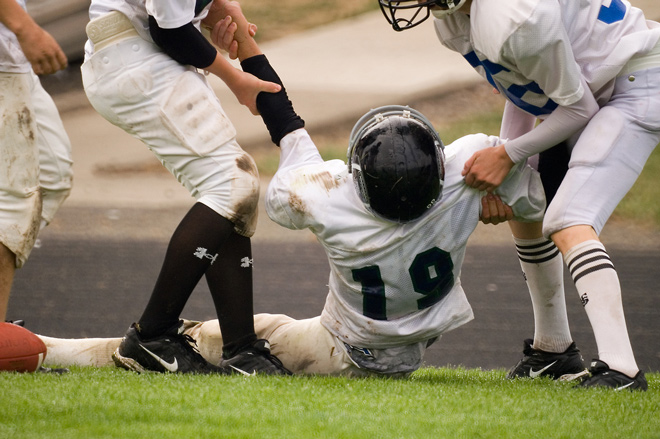|
Zackery doesn’t want others to end up like him. At 22, he walks with a looping gait, leaning heavily on a metal cane. He peers through thick glasses, specially designed to help his peripheral (side) vision. It takes him a moment to gather his thoughts before he speaks in a strained, thick voice. He struggles to remember his schedule day to day, and often relies on his mother to be his short-term memory schedule. Zack’s daily challenges stem from a traumatic brain injury he received while playing football when he was 13. In 2006, Zack nearly died after he got two concussions in a single football game, something called second impact syndrome. Although it’s not easy for him to get around, he’s spent the last 9 years speaking to lawmakers, coaches, athletic directors, trainers, health care workers, and parents about the dangers of concussions and what happens when they aren’t given time to heal. That’s why it was especially painful for Zack to watch the news about Kenney; the 17-year-old high school football player from Seattle who died earlier this month, 3 days after he received a head injury during a game. After his death, school officials revealed that Kenny, a wide receiver and defensive back, had suffered a concussion in September and had been cleared to play by health care professionals following the CDC’s guidelines. Had Zack sat out the rest of the game on Oct. 12, 2006, he most likely would be doing normal 22-year-old activities, like “out driving picking up chicks,” as he likes to joke. On that day, Zack suffered a concussion in the second quarter of the game when he made a tackle and hit the ground hard. He sat out for a while, but returned to the game in the second half. Zack took more hits but finished the game. As he walked off the field with his father, he collapsed and started to convulse. He was flown to Seattle’s Harborview Medical Center and came within an hour of dying from a catastrophic brain injury, says Richard G. Ellenbogen, MD, the hospital’s chief of neurological surgery.
0 Comments
Stress. It makes your heart pound, your breathing quicken and your forehead sweat. But while stress has been made into a public health enemy, new research suggests that stress may only be bad for you if you believe that to be the case. Psychologist Kelly McGonigal urges us to see stress as a positive, and introduces us to an unsung mechanism for stress reduction: reaching out to others.
1. You Are Creative Artists are not special, but each of us is a special kind of artist who enters the world as a creative and spontaneous thinker. While creative people believe they are creative, those who don't hold that belief are not. After acquiring beliefs about their identity, creative people become interested in expressing themselves, so they learn thinking habits and techniques that creative geniuses have used throughout history. 2. Creative Thinking Is Work You must show passion and the determination to immerse yourself in the process of developing new and different ideas. The next step is patience and perseverance. All creative geniuses work with intensity and produce an incredible number of ideas -- most of which are bad. In fact, more bad poems were written by major poets than by minor poets. Thomas Edison generated 3,000 different lighting system ideas before he evaluated them for practicality and profitability. 3. You Must Go Through the Motions When producing ideas, you replenish neurotransmitters linked to genes that are being turned on and off in response to challenges. Going through the motions of generating new ideas increases the number of contacts between neurons, and thereby energizes the brain. Every hour spent activating your mind by generating ideas increases creativity. By painting a picture every day, you would become an artist -- perhaps not Van Gogh, but more of an artist than someone who has never tried. |
Disclaimer: This website is for informational and educational purposes.
Any and all blog content represents a synthesis of empirical information found on the internet, of my own personal opinions, and my professional experiences. Nothing posted reflects or should be considered professional advice. Interaction with me via the blog does not constitute a professional or therapeutic relationship. For professional and customized advice, you should seek the services of a licensed mental healthcare professional. I do not assume liability for any portion or content of material on the blog and accept no liability for damage or injury resulting from your decision to interact with the website. Archives
August 2022
Categories
All
|

